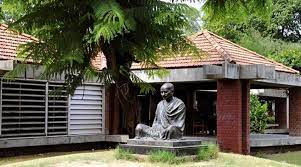29 Oct 2021 Sabarmati Ashram

- Mahatma Gandhi’s great-grandson Tushar Gandhi has moved the Gujarat High Court against the Gujarat government’s ₹1,200-crore plan to redevelop Sabarmati Ashram in Ahmedabad.
Issues with the project:
- The redevelopment plan involves extending its area from five to 55 acres by relocating residents to nearby areas.
- Tusha Gandhi says, this plan is diametrically opposed to the personal wishes of Mahatma Gandhi.
- The project would lead to the reduction of the shrine and memorial of the freedom movement and turning the ashram into a commercial tourist attraction spot.
How does the government defend its move?
- The Gujarat government has maintained that it would not change or alter any building on the ashram campus. All heritage buildings would be restored as per Gandhian ethos.
- The government has also maintained that the proposal to redevelop the ashram was not aimed at a takeover but to redevelop it by expanding the areas and creating a minimum infrastructure.
About Sabarmati Ashram:
- Mahatma Gandhi set up the ashram and lived there from 1917 to 1930.
- It was from his base here that Gandhi led the Dandi march also known as the Salt Satyagraha on 12 March 1930.
- Originally called the Satyagraha Ashram, reflecting the movement toward passive resistance launched by the Mahatma, the Ashram became home to the ideology that set India free.
Its role in freedom struggle:
- Experiments in living. farming, animal husbandry, cow breeding, Khadi and related constructive activities. For Gandhi freedom did not just mean no British rule, but freedom from social evils and freedom to live a satyagrahi lifestyle. He developed those in Sabarmati.
- Idea of Dignity in Labour: Intrinsic to the independence movement was upliftment of the masses. Campaigns for cleanliness became a part of the Gandhian idea of a new India and In Sabarmati Ashram both Gandhi Ji and Kasturbaji cleaned the Ashram themselves.
- Schools: While at the Ashram, Gandhi formed a school that focused on manual labour, agriculture, and literacy to advance his efforts for self-sufficiency. During the freedom struggle many Indian schools were opened as an alternate to British schools.
- Dandi March: From the Ashram, on 12 March 1930, Gandhi launched the famous Dandi march (with 78 companions) in protest of the British Salt Law.
- Home to leaders: Vinoba Bhave lived here as did Miraben.
Ashram’s relevance today:
- The Ashram reminds us to be hopeful and optimistic. It tells us to not thwart the vision of the Mahatma even in the face of immense adversity. The Ashram embodies the true memory of Gandhi, his pure truth and his utmost humility as his way of life.
- The Ashram still personifies the ideals of truth and humility of a man who once lived there and lived for a nation and died for a nation. A man who wanted these high ideals to be held high always by a nation so great as India.


No Comments